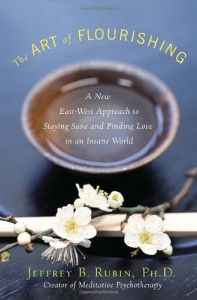 The Art of Flourishing Review
The Art of Flourishing Review

What do you get when you blend eastern philosophy with western psychology? A book called The Art of Flourishing by Jeffrey B. Rubin.
For those unfamiliar with his work Jeffrey Rubin is the creator of meditative psychotherapy whose previous books include Psychotherapy and Buddhism, The Good Life and A Psychoanalysis for Our Time.
The Art of Flourishing can be broken into two separate halves. The first half of the book deals with the self – “Planting The Seeds of Self Care”, while the second deals with building strong(er) relationships – “Cultivating The Garden of Love”. While these headings may sound a little flowery (excuse the pun) the language used in the text of book is much more direct.
“Too often we don’t really listen well to other people or to ourselves. […] Genuine listening helps us to become more receptive to what we are truly feeling.”
A common pitfall for these kind of books is a sense of “preachiness” as you turn the pages. It’s a pitfall that The Art of Flourishing manages to avoid thanks to the author being willing to admit to his own mistakes and flaws.
“The movies-on-demand function on my TV was malfunctioning. I had to wait longer than usual. I began to get disproportionately impatient and irritated. What had happened? I’m a long-term meditator who value equanimity but I was upset because I couldn’t watch a movie at the exact moment I wanted to – I had developed the habit of wanting instant results.”
Rubin writes passionately about various topics in the book including inner space, listening to the mind and body, passions and purposes, values, love and the use of power. He uses the tried and tested method of point, evidence, explanation to get his thoughts across to the reader.
In chapter 6 “Following Our Passion” Rubin discusses the importance of finding and following a healthy passion using the example of John Miller, a 74 year old jewelry artist. John had quit a lucrative job to follow his passion of stonework.
“The road was not without bumps and detours, but twenty years later, John Miller is a young and robust seventy-four. He does not work fewer hours than he did before, but he is doing something he loves passionately, and this love nourishes him in a way his corporate job and its financial security could not. ‘Now my work is my passion. I love what I do.’”
John took a risk and succeeded, on his own terms, and it’s these kind of stories that inspire the reader as they read on.
If you’re looking for an uplifting read that will give you the chance to look at your own life and see what needs working on then I fully recommend that you pick up a copy of The Art of Flourishing. It does not tell you what to think – it teaches you how to think – and I can’t think of much higher praise than that.
The Art of Flourishing is available from Amazon and all good book stores.
 Meditation for the Masses
Meditation for the Masses
Meditation’s beneficial attributes are supported by well documented and incontrovertible evidence. And the evidence is overwhelming. But what I’m interested in most about meditation, as I suspect many people are, is how meditation is relevant to daily modern life in concrete practical ways. I’m less interested in why it works or following traditional forms and rituals associated with meditation as I am in showing people that it can be very useful when integrated seamlessly into their daily routine.
Meditation can be hugely helpful to college students. The perception many people have of college students is of young people having the time of their lives and completely carefree. The truth is that college students have a lot on their plates. Students taking college classes, whether getting a B.A. in English on a traditional college campus or pursuing an associate degree in nursing online have to multi-task constantly. Taking a half hour to clear the mind and meditate is often an excellent antidote to a hectic student schedule. Think of it as a traditional study break but with better benefits. This is especially helpful during exam preparation when the brain feels overloaded with too many facts to possibly remember them all. Taking the time to meditate in a quiet place works wonders for the brain’s ability to recall information.
Meditation benefits people who have a problem with anxiety. The root causes of over-anxiety in individuals are often not irrational at all. Anxiety can be a completely natural reaction to the brain’s inability to problem solve. Our brains are sorting and sifting information all the time. Our ability to evolve alongside dangerous animals for millions of years depended on our brain’s highly developed ability to instantly identify danger and act accordingly. When we sleep our brains process information; perhaps as part of the dreaming process which allows us to learn. That’s why people will present you with a situation or problem and then say “why don’t you sleep on it and we’ll talk about it later.” It’s just intuitive that sleep helps us solve problems. Meditation seems to mimic some of the problem solving capacity of sleep. In the same way that meditation study breaks can help students retain information during exam preparation, frequent meditation for anxious individuals may help them identify root cause of anxieties.
Meditation is an especially useful tool for senior citizens. All of the research which shows that brain deterioration can be dramatically slowed by meditation is also supported in peer reviewed studies as well as brain scans. That’s been established. What I’m more interested in is the effect of meditation on physical ability in senior citizens and most importantly the impact on sense of wellbeing. Elderly people who have incorporated meditation into their daily routines have greater physical ability and stamina than those that don’t. That’s easy to measure. It’s hard to say for sure though whether this is a causal relationship or a correlation to other factors. It’s possible, for example, that an older person who has practiced meditation for years has also engaged in other healthy lifestyle choices such as healthy diet and vigorous physical exercise. Wellbeing is an intangible thing. That makes it hard to measure. However, older folks who meditate frequently report experiencing higher levels of wellbeing than those who don’t. Everybody can find an extra half hour for meditation too. And it doesn’t cost anything.
 Meditation for Pregnancy
Meditation for Pregnancy
 Pregnancy can be a happy and scary time for many women. Though they may feel excited and happy to welcome a new baby, they may also feel anxiety and stress about the responsibilities of parenthood and the physical toll of childbirth. It becomes more important than ever to focus on self-care during this time. Meditation can have many benefits for pregnancy, both physical and emotional.
Pregnancy can be a happy and scary time for many women. Though they may feel excited and happy to welcome a new baby, they may also feel anxiety and stress about the responsibilities of parenthood and the physical toll of childbirth. It becomes more important than ever to focus on self-care during this time. Meditation can have many benefits for pregnancy, both physical and emotional.
Symptom Relief
Regular meditation practice can help to alleviate many of the physical ailments of pregnancy. Meditation can help to relieve morning sickness and nausea, heartburn, fatigue, high blood pressure, and other symptoms. Regular practice can also better prepare your body for delivery, when you can use meditation to reduce the pains of labor and to help focus your mind to release fear and other negative emotions that can worsen the experience.
Emotional Benefits
Meditation can help to reduce stress and anxiety, increasing relaxation. This is especially important when you are pregnant, when everything you are feeling is also felt by your baby. Cultivating a more relaxed state of mind will help prepare you and your baby for delivery. Studies have also shown that mothers who regularly practiced meditation during pregnancy had babies that displayed calmer personalities and fewer rates of attention disorders.
Certain types of meditative practice, such as visualization and chanting, can also help you feel more connected to your baby during your pregnancy.
Hormonal Balance
One of the many physiological benefits of meditation is that it helps to balance hormones in the body, which can help reduce stress, manage pain, and improve overall health. Meditation has been shown to increase hormones such as DHEA (which reduces stress hormones cortical and adrenaline) and melatonin (which supports healthy immune function). Regular practice has also been shown to increase endorphins in the body, which help to mitigate pain – especially important during childbirth.
How to Practice
There are many types of meditation practice, and you should try different methods until you find the one that works best for you. Generally, most meditative practices rely on deep breathing, focusing on an object, visualization exercises, or repeating a mantra or chanting. You may find that one method works better for you, or you may find that a combination of these methods is more effective.
When you practice is also dependent upon what works best for you. Some may find that they are better able to focus on their meditation early in the morning when their minds are clear. Others may find that it is a useful way to unwind and process the day each evening. Choose the time that works best for you and try to be consistent in your practice. A daily practice would be ideal. You can meditate for as much time as you have available: If all you can spare is five minutes, you will still see benefits. Many recommend that you try for 15 to 20 minutes, if you can spare it.
Meditation is not like a rigorous exercise program that you have to follow for a certain amount of time for a certain number of days to see results. The key is to be consistent and to focus on what is right for you and your body. Over time, you will see the benefits – and so will your baby.